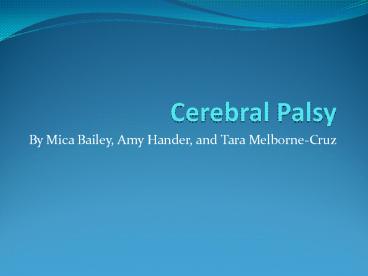Cerebral Palsy - PowerPoint PPT Presentation
1 / 12
Title:
Cerebral Palsy
Description:
CP affects body movement and muscle coordination ... http://emedicine.medscape.com/article/1179555-media. Types of Cerebral Palsy. Spastic CP ... – PowerPoint PPT presentation
Number of Views:750
Avg rating:5.0/5.0
Title: Cerebral Palsy
1
Cerebral Palsy
- By Mica Bailey, Amy Hander, and Tara Melborne-Cruz
2
What is Cerebral Palsy (CP)?
- Encephalopathy disorder
- Non-progressive
- CP affects body movement and muscle coordination
- Caused by injury to the brain during pregnancy,
labor, or after birth
http//emedicine.medscape.com/article/1179555-medi
a
3
Types of Cerebral Palsy
- Spastic CP
- Athetoid or dyskinetic CP
- Ataxic CP
- Other CP
- Rigid
- Tremors
- Flaccid
- Mixed
4
Spastic Cerebral Palsy
- Most common type of CP affecting 70-80 of
patients - Characterized by
- Increased muscle tone
- Primitive reflexes
- Deep tendon reflexes
- Clonus (repetitive contractions)
- Rigidity of extremities
- Scoliosis
- Contractures
http//www.burke-eisner.com/media/cerebral-palsy-S
mall.JPG
5
Athetoid or Dyskinetic CP
- Second most common type of CP- affecting 10-20
of patients - Characterized by difficulty with fine motor
coordination resulting in movements that are - Jerky
- Uncontrolled
- Abrupt
http//happyhornets13.wikispaces.com/file/view/WHY
Y.jpg
6
Ataxic CP
- Less common type of CP affecting 5-10 of
patients - Affects balance and coordination
- Characterized by
- Disturbances in gait
- Instability
http//www.jasontshields.ws/files/users/d/535D646F
23FB2048E040A8C0AC002D4E/5bd0e004928ef2dd27e13815e
1118683.jpg
7
Other Types of CP
- Tremors are a rare form of CP
- Rigid CP affect 5 -10 of patients
- Flaccid (Hypotonicity)
- Mixed symptoms affect 15 - 40 of CP patients
- The most common mixed form includes spasticity
and athetoid movements.
8
Etiology/Pathology
- Exact cause is unknown
- Most likely due to brain damage-
- possible cause being anything that
interferes with oxygen to the brain. - Damage usually occurs during fetal development,
before, during, or after birth, or during infancy.
9
Possible Causes
- Prenatal
- Maternal infection
- Nutritional deficiencies
- Kerniceterus
- Maternal Analgesia
- Teratogens
- Postnatal
- Head Trauma
- Infection
- Neoplasm
- CVA
http//www.texastriallawyer.com/images/Naduah1.jpg
10
Diagnosis
- Specific Tests (used to rule out progressive
disease) - MRI
- EEG
- Intelligence test
- Vision test
- CT
- Hand preference
- Reflex test
http//www.scielo.br/img/fbpe/anp/v59n1/n1a06f01.j
pg
11
Treatment
Management is better than treatment
- PT strengthen large muscles, decrease
contractures - OT strengthen small muscles, teach ADLs
- Speech Therapy improve speech and eating
- Drug Therapy control/decrease seizures
- Surgery decrease contractures/spasticity
- Sensory Integration improve balance/coordination
- Adaptive Therapy make moving life easier
- Adaptive Equipment
- Medical Nutrition Therapy
http//www.littlecharlierocks.com/images/6-28-05_0
091_umjg_sjts.jpg
12
References
- http//www.ucp.org/































